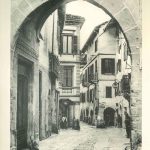Dogliani
The history
The history
Dogliani (Dojan in Piedmonts dialect) has pre-Roman origins: as we can see both from the both toponimy and from recent archaeological finds.
There is in fact evidence of a settlement of populations of Ligurian and Celtic origins. Between the 1st and 2nd centuries, AD Dogliani was a Roman village. There are many finds of this historian age especially in the area of San Quirico, and the finding of an ancient necropolis. During the low roman empire – the period of the decadence of the roman empire beginning in 476 AD – the center of town moved to the Pieve then continued to move, until it established on the fortified area: the castrum, to defend the population against the raids from the Hungarian and Saracens Saracens (10th century).

The present structure of Dogliani is the result of the middle Ages: the castle dominates the hills and the village, at the lower part of the village is surrounded by fortifications. The medieval core is still well recognizable today, delimited by the two ancient gateway to the village: Porta Soprana and Porta Sottana. In the early Middle Ages Dogliani was part of the Count of Alba, then passed to the Aleramici of Vasto and then to the Marquis of Busca. In the 12th century, Dogliani obtained with some treaties its first municipal government autonomy. During this period and until the middle of the fifteenth century, in Dogliani there were permanent political party in-fighting between the families of Monferrato, Saluzzo, Acaia and Visconti.
In the sixteenth century Dogliani was occupied first by the French and then by the Spanish due to the war between Francis I of France and Charles V of Spain for the domination in Europe. With the Treaty of Lyon in 1601 Dogliani, and other towns, passed to the Savoy family, which gave it as feud to the families Solaro of Moretta and the Solaro of Borgo. Napoleon and the so-called French “liberators”, only replaced the previous mindful of the fires that burned Marsaglia, Castellino and Belvedere Langhe).
Dogliani come back to shine, in the nineteenth century. The architectural works of architect Giovan Battista Schellino (1818-1905) bear witness to this flowering. The urban structure was largely changed by the eclecticism of this distinguished “urbanist”, who gave with his works an unusual style to the village. He created unusual new corners, compared to the time when they were built, giving to Dogliani a monumental aspect that surely does not go unnoticed.
In particular, in the afternoon of 31 July 1944 a military aircraft that is still being discussed today whether it was a German plane or not, was flying low almost touching the roofs of the houses, headed towards the center of the village and dropped a bomb.
The plane drove away to the Codevilla region and then returned and dropped other two bombs. The death toll was 28, all civilians, 13 buildings destroyed and several houses damaged. The following day Nazi-Fascist troops began a round-up in this town, considering Dogliani a den of partisans.
After the war, Dogliani gradually returned to being what it has always been: an important agricultural center, a special place for trade. Even today, Dogliani, despite a growth of local crafts, is characterized by a traditional economy based on farming.
People remained faithful to the vineyard seem to have treasured the teachings of Luigi Einaudi, the illustrious economist and statesman, who between 1945 and 1948 reshaping Italy and who later became the first President of the Italian Republic until 1955. Luigi Einaudi wrote in his notes dedicated to business management:
“You live with the fruits of your own labor. If there is an income…, first you have to think about renewing the plantings… and do all the various conservation and improvement works of the land and the rural houses”
Wine growers and winemakers of Dogliani have followed this teaching. Although the structure of their companies is mostly small, their organization is a business organization with investments in vineyards and in the wine cellars to optimize the quality of productions.
For the winemakers of the Lange of Dogliani all these centuries of history of their wine would not be a source of pride if today Dalianis were not present where we talk about quality wine.
Curiosity
The history of Dogliani is a wine story and the ethic “Dolium” would confirm it: a spherical terracotta container used mainly for the transport of wine on ships (height between 1.50 and 1.60 meters and width greater than 1.50 meters.
Its capacity was about 1500-2000 liters. The “dolias” were fixed in the central part of the boat, while the space left free at the stern and bow was occupied by the load of amphorae). Other says its name comes from “Dolium Januae”, meaning a “Giano cup “. It is not a coincidence that the lion of the heraldic symbol of the town holds a cup.






